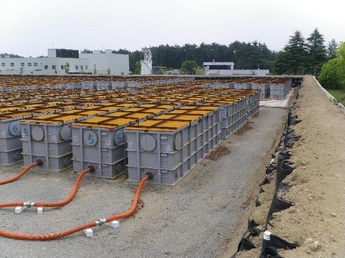TEPCO started up a large-scale water treatment system at the damaged Fukushima Daiichi NPP on 18 June, and then stopped it four hours later due to increases in measured radioactivity.

TEPCO said only that the 1200 ton/day system was stopped because of increase of radiation dose 'at surface level' up to caesium adsorption exchange filter.
The system consists of several different processes organised in sequence: a Toshiba oil separation system, a Kurion caesium adsorption tower, an Areva-designed decontamination system and a Hitachi desalination system.
Reports from Japanese news channel NHK have offered extra details of the situation. It said that a test of the system was carried out on Sunday night, and analysed the data on Monday. Initially, engineers expected to find large amounts of radioactive sludge and oil. But in fact the system was found to be set to the lowest of three radioisotope absorption levels.
Therefore, TEPCO has concluded that trouble might have been due to the water having a higher level of radioactivity than expected, NHK reported. As a result, it may increase the amount of oil separation equipment, or decrease the system's flow rate. TEPCO adjusted the flow rate through the system in a further test on Monday, although no results were immediately available.
About 500 tons of water is being added to the system to cool the reactors per day. Current storage space could run out in as little as a week, if the treatment system is not restarted, NHK reported. The reports were published on the web site of the Japan Atomic Industrial Forum.
Several other wastewater treatment operations also began 17-18 June, according to TEPCO reports. For 36 hours ending 20 June, TEPCO staff pumped water from the unit 3 turbine building to the Miscellaneous Solid Waste Volume Reduction Treatment Building. Boreholes sunk last week suggested that the facility was not leaking.
Also on 20 June, freshwater injection began to the unit 4 and unit 5 reactor wells and temporary equipment pools to reduce radioactivity of their fifth floors.
And on 17 June, pumping began from the unit 2 trench to the unit 1 condenser, but was halted 30 minutes later when it was observed that the water was not flowing; the cause is being investigated.
Finally, on 20 June, TEPCO operators opened the unit 2 reactor building airlock to improve working conditions inside the reactor. It said that there was no significant impact on radiation dose by opening the door. Workers have operated an air filtering system inside the reactor for about a week to reduce levels of airborne radiation.




